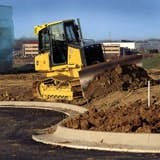The design of the Weldco-Beales 6-Way Blade allows the dozer operator to hydraulically adjust and set the power angle/tilt (PAT) blade for grading, trimming, sloping or ditching, among a variety of tasks.
While durable trunnion ball connections and heavy-duty angling and tilting linkages provide enhanced blade reliability, a compact design promotes good tractor balance. Moldboard visibility further supports operator performance and worksite safety.
With headquarters in Edmonton, Alberta, Weldco-Beales designs and manufactures specialized heavy equipment attachments and cranes for the construction, forestry, mining and road maintenance industries.
Traditionally, the worlds of finish and production dozers collide within the 100- to 200-horsepower range. While they may still, the proverbial line in the dirt is moving toward the upper part of that range, and growing much less discernible along the way. It's fuzzy, if not completely smudged.
The players in this market — Caterpillar, Case, John Deere, Komatsu, Dressta and Liebherr — continue to offer a plethora of undercarriage options resulting in various versions of their assorted models. Regardless, crawler dozers, particularly in this size range, are increasingly less either a finish grading or a production machine, but rather both.
"What drives some of that is customers today want to have pieces of construction equipment that will serve multiple functions, as opposed to having one piece of equipment to do one thing and another piece of equipment to do another," says Jim Hughes, marketing manager, Case Construction Equipment. "The machines don't make money when they're sitting there either idling or with the engines off, parked on the side of the jobsite."
With list prices approaching $300,000, machines positioned at the top end of the 100- to 200-horsepower range, once renowned primarily for their brawn, are proving to be crafty blade handlers as well. "We are definitely seeing that more and more contractors are using larger dozers to do more finish grading," says Les Scott, Komatsu America's senior product manager, crawler tractors. The end-user's collective confidence in machine control and positioning technologies such as GPS, laser and electronic blade control is being manifested in earthmovers as precise as they are tough.
"I believe that's part of the reason why the demand has stayed really solid in the larger sizes," says Dan Drescher, John Deere's product marketing manager for crawlers. "As a good example, you see more 200-horsepower machines today with six-way or PAT blades."
John Deere provided one of the true head-turning moments at Conexpo-Con/Agg 2008 with the unveiling of the 764 High-Speed Dozer, an articulated-framed, quad-tracked, 200-horsepower tractor bringing together the motor grader and crawler dozer. The mass market won't see this revolutionary machine until 2009.
That hasn't prevented the company from continuing to refine its hydrostatic J-Series crawler dozers — the 700J, 750J and 850J in the 100- to 200-horsepower size class — with more operator preferences available for both transmission speeds and hydraulic speeds, yet without sacrificing fuel economy during Tier-3 engine upgrades. "The ability to make these adjustments makes a machine that much more versatile," says Drescher. "We also offer an extended-life undercarriage system on these tractors with our SC-2 (slurry coating) bushing technology. It's been out now for a number of years, but it's becoming a more popular option on this size-class tractor, again because it does lower owning-and-operating costs."
Deere's integrated grade control option is likewise available on all three of the company's dozers in this range. "Again, that plays into that versatility," says Drescher, "to be able to take a machine from rough grade to finish grade." Dozers equipped with the option are shipped from the factory with the hardware, software and wiring needed to support the customer's electronic grade control system of choice. An open architecture enables the dozers to operate products from the top aftermarket laser system providers, "and because this system is not an add-on and the factory-sized hydraulic valves are tuned for the specific machine from the beginning, Deere products deliver faster response and enhanced performance," says Drescher. "There's no guesswork as to whether the crawler will work with your favorite system."
This goes to the Deere approach to its product line.
1 | 2 | NEXT PAGE





